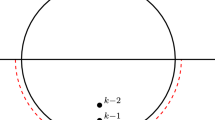Abstract
In this paper a new iterative boundary element method (BEM) is developed to solve singular Cauchy problems in isotropic linear elasticity. In order to deal with the difficulties associated with the instability caused by the prescription of the boundary data and the low rate of convergence manifested by standard numerical techniques, the iterative algorithm proposed by Kozlov et al. [1] is combined with the singularity subtraction technique, see Portela et al. [2]. A regularising stopping criterion is developed and, moreover, for a given physical geometry and loading of a cracked elastic medium, the convergence and the stability of the algorithm proposed are numerically investigated for both exact and noisy data. The conclusion of this paper is that if a singular problem is encountered then a singularity based technique, such as that described in Sect. 2, should be employed. In addition, if this singular problem is such that inverse analysis in necessary, such as in crack problems, then a suitable regularisation method should be applied to the regular problem obtained by taking into account the singularity, and not to the singular problem with the singularity ignored.
Similar content being viewed by others
Author information
Authors and Affiliations
Additional information
Received 19 October 2001 / Accepted 4 February 2002
Rights and permissions
About this article
Cite this article
Marin, L., Elliott, L., Ingham, D. et al. An iterative boundary element algorithm for a singular Cauchy problem in linear elasticity. Computational Mechanics 28, 479–488 (2002). https://doi.org/10.1007/s00466-002-0313-3
Issue Date:
DOI: https://doi.org/10.1007/s00466-002-0313-3




